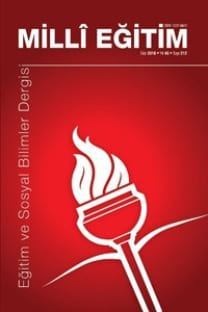BİÇİMLENDİRİCİ DEĞERLENDİRMEYE YÖNELİK ÖĞRETMEN ADAYLARININ DÜŞÜNCELERİ
Bu çalışma, 2006-2007 eğitim-öğretim dönemi güz yarıyılında, KTÜ,Artvin Eğitim Fakültesi İlköğretim Bölümü Sınıf Öğretmenliği Programı üçüncü sınıfta öğrenim gören toplam yirmi beş öğretmen adayı ile ÖğretimTeknolojileri ve Materyal Geliştirme (ÖTMG) dersi kapsamında yürütülmüştür.Dört aşamalı araştırmanın ilk aşamasında öğrencilere, kavram ağı, kavram haritası, çalışma yaprağı ve yapılandırılmış grid gibi öğretim materyalleri hazırlamak için gerekli bilgiler sunulmuştur. İkinci aşamada; öğretim materyallerigeliştirmeleri ve sınıfta sunmaları istenmiştir. Üçüncü aşamada; öğretim materyalleri araştırmacılar tarafından incelenerek, hatalar ve eksiklikler her bir öğrenciye dönüt olarak verilmiştir. Son aşamada ise öğrencilerin verilen dönütleregöre ödevleri tekrar hazırlamaları ve sunmaları istenmiştir. Bu süreç sonundaöğrencilerde meydana gelen değişme ve gelişmeler yarı yapılandırılmış mülakatlarla belirlenmiştir. Çalışma sonucunda adaylar, verilen geribildirim ile eksikve iyi yönlerinin farkına vardıkları ve ona göre çalışmalarını yönlendirebildiklerini, kendi kendilerini değerlendirmeyi öğrendiklerini ve eleştirel düşünmeyeteneklerinin geliştiğini ifade etmişlerdir
Anahtar Kelimeler:
Ölçme-değerlendirme, yapısalcı yaklaşım, biçimlendirici değerlendirme, öğretim teknolojileri ve materyal geliştirme
PROSPECTIVE TEACHERS’ VIEWS ABOUT FORMATIVE ASSESSMEN
This study was carried out with 25 junior elementary student-teachers at Karadeniz Technical University, Artvin Education Faculty Primary Education Department Elementary Teaching in the fall semester of 2006. The study was a part of an Instructional Technologies and Material Development course. It was applied in four parts. In the first part, basic knowledge was given to students which consist of concept map, semantic feature analysis, worksheets, and structured grid. In the second part, students were asked to develop and present their materials in the classroom. In the third part, materials were investigated by the researchers, and feedback was given to each student. In the last part, students were asked to correct and present their materials in the classroom again according to the feedback. At the end of this process, changes and developments in students’ views were determined by semi-structured interviews. The results of the study showed that elementary student-teachers’ critical thinking skills were developed, they learned self assessment, they noticed their mistakes and deficiencies and they reorganized their studies by correcting their mistakes and deficiencies
Keywords:
Measurement-assessment, constructivist approach, formative assessment, instructional technologies and material developmen,
- ISSN: 1302-5600
- Yayın Aralığı: Yılda 4 Sayı
- Başlangıç: 1973
- Yayıncı: Milli Eğitim Bakanlığı
Sayıdaki Diğer Makaleler
BİÇİMLENDİRİCİ DEĞERLENDİRMEYE YÖNELİK ÖĞRETMEN ADAYLARININ DÜŞÜNCELERİ
TARİH DERSİ SINAV SORULARININ BLOOM TAKSONOMİSİ’NİN BİLİŞSEL ALAN DÜZEYİ AÇISINDAN SINIFLANDIRILMASI
Kerem - İsmail H ÇOLAK-DEMİRCİOĞLU**
COĞRAFYA EĞİTİMİNDE HARİTA ALGISI VE KULLANIMI
GÖRSEL SANATLAR EĞİTİMİNDE ÖLÇME VE DEĞERLENDİRME SÜRECİ ÜZERİNE
GÖRSEL KÜLTÜR VE MEDYA OKURYAZARLIĞI: Sanat Eğitiminin Kamusal Açılımı
SOSYAL BİLGİLER DERSİ VE DEĞERLER EĞİTİMİ
GÖRSEL KÜLTÜR VE MEDYA OKURYAZARLIĞI: Sanat Eğitiminin Kamusal Açılımı
BEDEN EĞİTİMİ ÖĞRETMENLERİNİN YETERLİLİKLERİ ÜZERİNE BİR DERLEME
